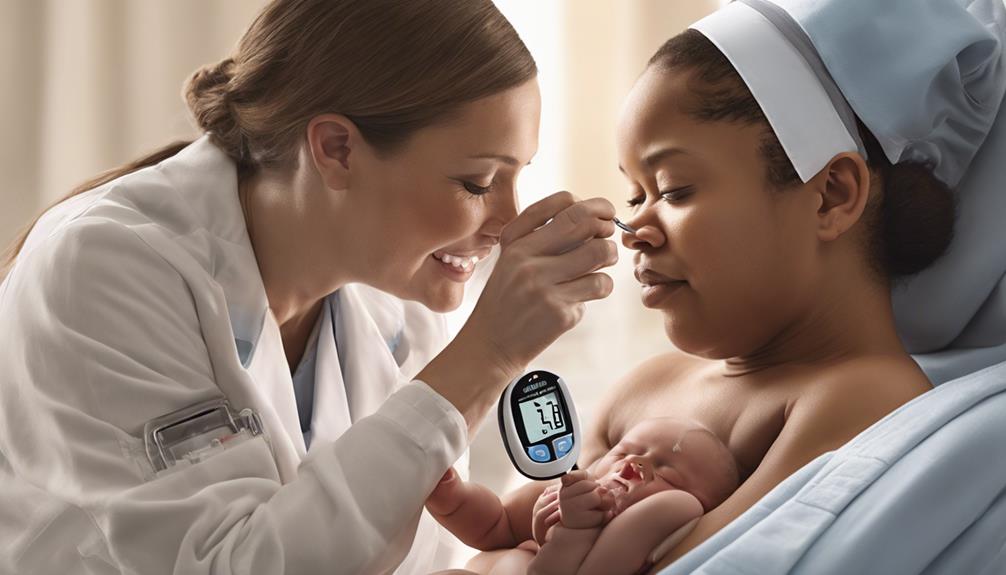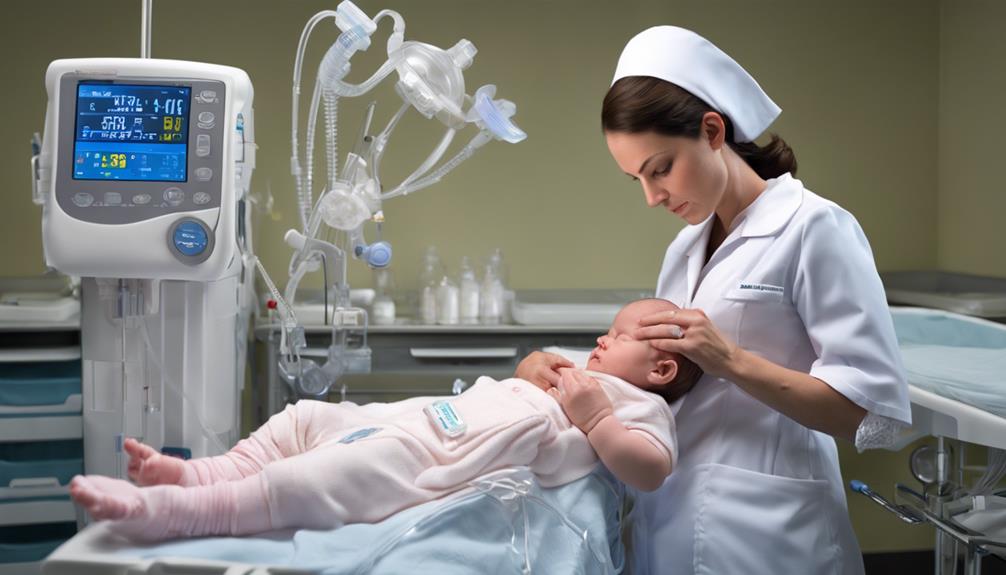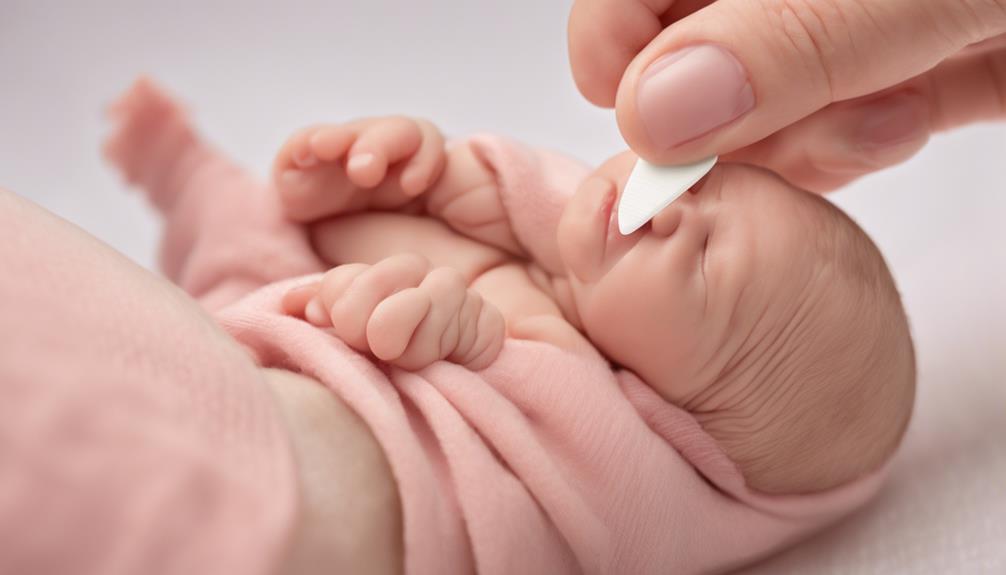In the care of newborns, an underappreciated aspect is the crucial need to keep their body temperature within a tight range. As healthcare professionals, we are tasked with the challenge of optimal thermoregulation for these fragile patients.
Understanding how to create a thorough nursing care plan specifically tailored to address newborn thermoregulation can greatly impact their well-being. Let's explore the essential steps and strategies involved in this meticulous process to safeguard the health and stability of the newborns under our care.
Key Takeaways
- Prioritize effective thermoregulation strategies for newborns' health and well-being.
- Implement skin-to-skin contact for temperature stability and bonding.
- Dress infants in appropriate clothing to prevent temperature fluctuations.
- Maintain a warm, draft-free environment to support newborn thermoregulation.
Importance of Newborn Thermoregulation
Ensuring proper thermoregulation in newborns is paramount due to their vulnerable state and underdeveloped temperature control mechanisms. Infants have a higher risk of hypothermia because of their large surface area to body mass ratio. This makes it essential for nurses to provide meticulous care to maintain the newborn's body temperature within the normal range. Adequate thermoregulation supports essential metabolic processes vital for the infant's growth and development.
Skin-to-skin contact is a simple yet effective method to help regulate a newborn's temperature. This intimate approach not only provides warmth but also fosters a strong bond between the infant and caregiver. Additionally, selecting appropriate clothing and controlling environmental factors such as room temperature play significant roles in ensuring the baby's comfort and well-being. Neglecting thermoregulation can lead to complications like hypoglycemia and respiratory distress, underscoring the importance of vigilant nursing care in this aspect.
Assessment Techniques for Thermoregulation

Evaluating a newborn's body temperature with a thermometer is an important initial step in determining their thermoregulation status. Monitoring skin color, capillary refill, and overall appearance can provide valuable insights into the presence of hypothermia or hyperthermia. Additionally, checking for cold stress indicators such as jitteriness, increased respiratory rate, and skin mottling is key.
It's essential to assess the newborn's environment for factors that may impact temperature regulation, such as room temperature and clothing. Observing the newborn's activity level and response to interventions aimed at maintaining the best body temperature is fundamental in ensuring their well-being.
Interventions for Thermoregulation Stability
Implementing skin-to-skin contact is a foundational intervention for promoting newborn thermoregulation stability and fostering a strong bond between the infant and caregiver. This intimate practice not only helps regulate the baby's temperature but also enhances the emotional connection between the two.
To further support thermoregulation, consider the following:
- Utilize radiant warmers or incubators: These tools, equipped with skin temperature monitoring capabilities, provide precise control over the newborn's thermal environment.
- Monitor ambient room temperature: Keeping a close eye on the room temperature helps guarantee heat loss prevention and assures the baby is in a comfortable setting conducive to thermal stability.
- Dress newborns in appropriate clothing: Outfitting infants in suitable attire, including hats and blankets, helps prevent heat dissipation and promotes thermal comfort.
- Educate caregivers: Providing caregivers with essential knowledge on maintaining consistent room temperatures and avoiding drafts empowers them to actively participate in supporting the baby's thermoregulation needs.
Monitoring Strategies for Thermoregulation

Monitoring newborn thermoregulation involves regularly evaluating skin temperature, core temperature, and environmental temperature to guarantee top comfort and stability.
To make certain the health and well-being of the infant, utilizing skin-to-skin contact can be a pivotal method for monitoring and regulating body temperature effectively.
Continuous temperature monitoring devices such as skin probes or thermal sensors play an essential role in providing accurate assessment of the newborn's thermal status.
It's essential to watch for any signs of cold stress or heat stress in newborns, intervening promptly to maintain thermal balance.
Additionally, dressing the infant appropriately for the environment is crucial to prevent fluctuations in body temperature and support the best thermoregulation.
Enhancing Newborn Health Outcomes
To optimize the health outcomes of newborns, it's imperative to prioritize strategies that promote effective thermoregulation and overall well-being. When caring for newborns, enhancing their health outcomes is a multifaceted process that requires attention to detail and a compassionate approach.
Here are four key ways to improve newborn health outcomes:
- Implementing Skin-to-Skin Contact: Encouraging skin-to-skin contact between the newborn and the caregiver helps regulate the baby's temperature and fosters bonding.
- Maintaining Proper Clothing: Dressing newborns in appropriate clothing for the environment can aid in preventing temperature fluctuations and ensuring they stay warm.
- Controlling the Environment: Creating a warm and draft-free environment for newborns can support their thermoregulation and overall comfort.
- Prompt Interventions: Monitoring newborns closely for any signs of hypothermia or hyperthermia and intervening promptly can prevent complications and optimize health outcomes.
Frequently Asked Questions
What Are the Guidelines for Thermoregulation of Newborns?
Maintaining a newborn's body temperature within a neutral range is important for their well-being. Strategies like using radiant warmers, skin-to-skin contact, monitoring temperature, and appropriate clothing help prevent heat loss or overheating. Close monitoring and adjustments guarantee comfort and stability.
What Nursing Interventions Are Essential to Ensure Adequate Thermoregulation in the Newborn?
We closely monitor the newborn's temperature, guarantee a warm environment, and educate parents on proper care. By utilizing skin-to-skin contact, monitoring regularly, and providing a cozy setting, we empower families to safeguard their newborn's thermoregulation.
What Is a Nanda Nursing Diagnosis for Thermoregulation?
We identify newborns at risk for temperature instability through a NANDA nursing diagnosis for thermoregulation. It guides interventions to maintain body temperature within a normal range, preventing complications and promoting ideal health and well-being.
What Is the First Step for Thermal Protection of Newborn?
Ensuring immediate skin-to-skin contact with the mother after birth is the important first step for thermal protection of a newborn. It helps regulate body temperature, stabilize essential signs, promote bonding, and boost the baby's immune system.
Conclusion
In summary, maintaining essential body temperature in newborns is pivotal for their health and well-being.
Did you know that approximately 50% of newborns experience some degree of hypothermia in the first few hours after birth?
By diligently evaluating, monitoring, and implementing interventions for thermoregulation, healthcare professionals can greatly improve outcomes for these vulnerable infants.
Let's continue to prioritize newborn thermoregulation to guarantee the best possible start in life for our little ones.










